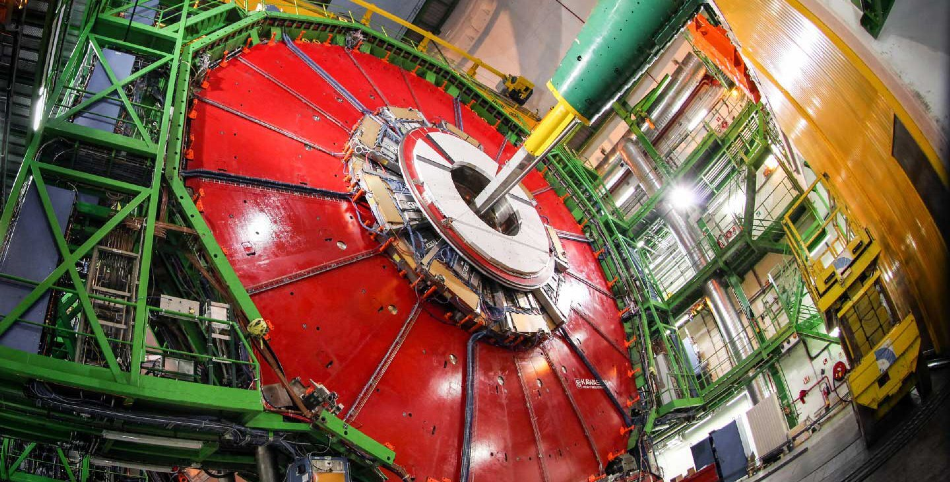Oct 8 2020
In 2012, when the Higgs boson was eventually discovered in a mix of other particles produced at CERN’s Large Hadron Collider (LHC) in Geneva, Switzerland, it gained fame overnight.
 Compact Muon Solenoid experiment at the Large Hadron Collider. Image Credit: CERN/CMS.
Compact Muon Solenoid experiment at the Large Hadron Collider. Image Credit: CERN/CMS.
The discovery was phenomenal since the Higgs boson, which had been proposed earlier, has the unique property of providing elementary particles with mass. Moreover, it is extremely rare and challenging to find in the debris of colliding particles.
Physicists at Caltech had a crucial role to play in the discovery of Higgs boson—a finding that helped theoretical physicist Peter Higgs earn a share of the 2013 Nobel Prize in Physics. Currently, the physicists have been continuously achieving important findings related to rare Higgs boson processes.
For the first time, this summer, particle physicists have used data gathered by the so-called Compact Muon Solenoid (CMS) experiment at the LHC and found evidence that the Higgs boson decays into a pair of elementary particles known as muons.
The muon is a heavier variant of the electron, and both electrons and muons constitute a family of particles called fermions, as explained in the generally accepted model of particles known as the Standard Model. In the Standard Model, all particles are classified either as bosons or fermions. In general, fermions are basic constituent elements of all matter, and bosons are the carriers of force.
Moreover, a muon is a so-called second-generation particle. First-generation fermion particles like electrons are the lightest particles. Second- and third-generation particles can decay and transform into first-generation particles. The latest results form the first-ever evidence that the Higgs boson interacts with second-generation fermions.
Furthermore, this finding offers more evidence that the decay rate of the Higgs boson to fermion pairs is proportional to the square of the mass of the fermion. This is one of the most important predictions of the Higgs theory. With additional data, it is expected that the LHC experiments will confirm that, in fact, the Higgs boson offers the fundamental particles their mass.
The importance of this measurement is that we are probing rare processes involving the Higgs boson, and we are in the precision Higgs physics investigation regime where any departure from the Standard Model predictions can point us to new physics.
Maria Spiropulu, Professor of Physics, Caltech
Researchers who studied the data from another instrument at the LHC, called ATLAS (A Toroidal LHC Apparatus), also discovered supporting evidence for the decay of the Higgs boson into muons. The results of both the experiments were reported at the 40th International Conference on High Energy Physics in August 2020.
“We need more data and clever analysis methods to confirm our results, but this is the first time we are seeing evidence that the Higgs boson decays into two muons,” noted Irene Dutta (MS ’20), a Caltech CMS team member and graduate student in Spiropulu’s laboratory.
“This result validates experimentally that the predictions of the Standard Model of particle physics are spot-on. Even a small deviation from our model would tell us something else is going on, but so far the Standard Model remains firm,” added Dutta.
The study results will eventually enable researchers to gain better insights into how the Higgs boson contributes mass to the fermions. The Higgs boson can be considered as the excitation or jiggling of the Higgs field. The Higgs field serves as a thick syrup and when particles travel through it, they obtain the mass; the slower the particles travel through the field, the heavier they are.
We want to understand the origin of mass in our universe. The Higgs boson is an experimental tool for understanding this mechanism, and could be a handle for discovering new physics. We can’t systematically observe the Higgs boson or other elementary particles, except in their manifestation in high-energy particle collisions, but they are the basic building blocks of our universe.
Nan Lu, Member, CMS Team, Caltech
Lu is also a postdoctoral scholar in Spiropulu’s laboratory.
The Caltech group helped achieve the new study result by looking for Higgs bosons generated by a specific mechanism by which two particles known as quarks are also produced simultaneously (quarks are another type of fermion). This process is of specific interest since both the quarks provide unique signatures to help determine the Higgs bosons.
Lu devised the method to investigate the sensitivity of the CMS search for different masses of the Higgs boson, thus enhancing the confidence of the findings. Dutta strived to demonstrate the power of a sophisticated artificial intelligence (AI) methodology tool, called a deep neural network, to analyze the LHC data.
Both Dutta and Lu contributed to the derivation of the final results related to the sensitivity. Joosep Pata, a former Caltech postdoctoral scholar who is currently associated with the faculty of the National Institute of Chemical Physics and Biophysics in Estonia, created innovative techniques to accelerate the complex computational analysis used in the project.
Probing the properties of the Higgs boson is tantamount to searching for new physics that we know has to be there. I am especially proud of the work by Nan, Irene, Joosep, and the entire Caltech CMS group, whose talent, diversity, and results shine in the landscape of a grand international collaboration.
Maria Spiropulu, Professor of Physics, Caltech
Other members of the Caltech CMS team are Harvey Newman, Marvin L. Goldberger, Professor of Physics; Si Xie, research assistant professor of physics; research scientists Adi Bornheim and Cristián Peña (MS ’15, PhD ’17); and Ren-Yuan Zhu, manager of the Caltech CMS electromagnetic calorimeter team.
Journal Reference:
Lykken, J & Spiropulu, M (2020) The future of the Higgs boson. Physics Today. doi.org/10.1063/PT.3.2212.